Exploring Berlin by rail
The German capital boasts some fascinating railway architecture, from timbered cottages to cathedral-style underground stations and ultra-modern designs. Chris Milner paid a visit to seek them out.
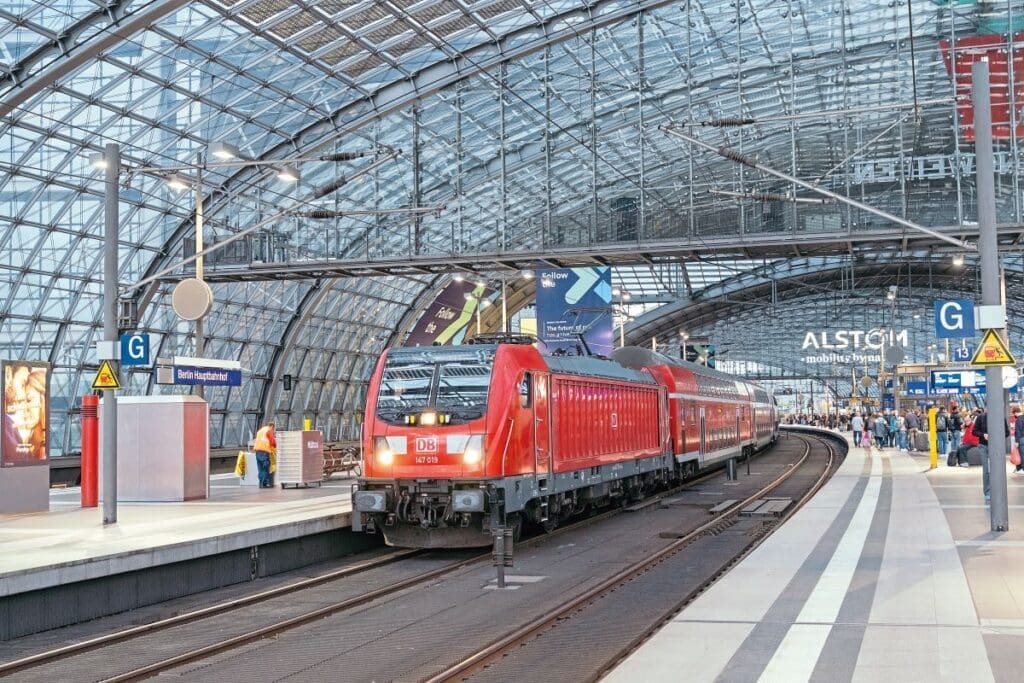 Berlin’s main station is Hauptbahnhof, the split-level station being located on the site of the former terminus Lehrter Bahnhof. It was formally opened onMay 26, 2006 after a lengthy construction. Platforms are on both a north-south and east-west axis and the steel and glass structure is visually impressive, especially at night. The upper level of the station has three island platform faces (including a pair used by the S-Bahn), while the lower level has four island platforms faces plus an additional island platform for U-Bahn services. DB electric No. 147 019 waits with a double deck train to Cottbus on September 24, 2022.
Berlin’s main station is Hauptbahnhof, the split-level station being located on the site of the former terminus Lehrter Bahnhof. It was formally opened onMay 26, 2006 after a lengthy construction. Platforms are on both a north-south and east-west axis and the steel and glass structure is visually impressive, especially at night. The upper level of the station has three island platform faces (including a pair used by the S-Bahn), while the lower level has four island platforms faces plus an additional island platform for U-Bahn services. DB electric No. 147 019 waits with a double deck train to Cottbus on September 24, 2022.
Home to almost 3.6 million people, Berlin has expanded and modernised considerably since reunification in 1990. For its residents, the city’s impressive public transport system – covering rail, tram, ferries and bus – is the backbone of the day-to-day, with a comprehensive and interconnecting system operated by BVG (Berliner Verkehrsbetriebe) which was founded in 1928. The BVG network is extensive and there are many places where the S or U-Bahn connects to DB network services.
At the end of the Second World War, Berlin was split into four sectors divided between the British, American, French and Soviets – but it was the construction of the infamous Berlin Wall, completed in August 1961, that segregated around one million people in East Berlin (and what was then East Germany) under the control of the German Democratic Republic allied to the Soviet regime. Much of the city’s historical and cultural sector was in the East, and much of today’s tram network was also originally in the former East.
Article continues below…Advert[1]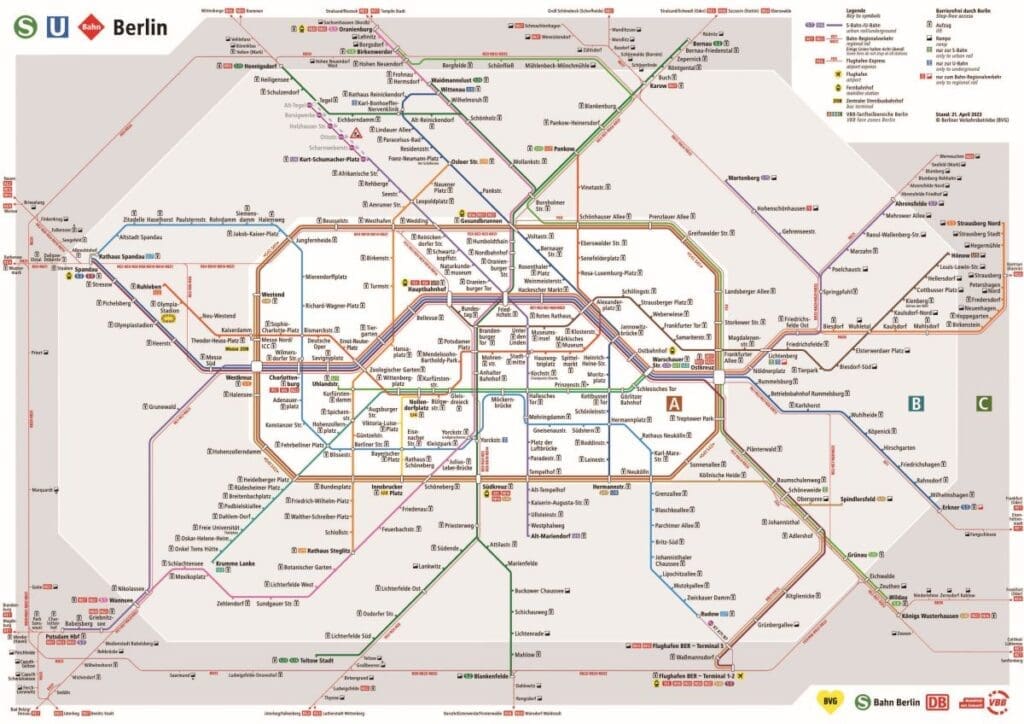 An extract from Berlin’s rail network map. Due to the size of the network map, some stations mentioned may be beyond the visible boundary. A PDF map can be downloaded from www.bvg.de[2]
An extract from Berlin’s rail network map. Due to the size of the network map, some stations mentioned may be beyond the visible boundary. A PDF map can be downloaded from www.bvg.de[2]
Its wider railway history is particularly fascinating and, while outside of the scope for this article, is worthy of deeper investigation, as there have been so many changes since the end of the Second World War. These changes are still happening too. In December 2020, a new 2.2km link between Brandenburger Tor and Alexanderplatz opened, creating a through route from Hönow in the east to Berlin Hauptbahnhof, the city’s main station.
Hauptbahnhof is an impressive modern glass, steel and concrete design, with trains running on both north-south and east-west axes, built on the site of Lehrter Bahnhof with construction beginning properly in 1995 and completion not achieved until 2006.
 A trip to Berlin should include the wonderful Oberbaumbrücke, a landmark double-deck bridge that spans the River Spree. It links Friedrichshain and Kreuzberg, areas that were divided by the Berlin Wall. The lower deck is a road, while the upper deck carries U-Bahn lines U1 and U3, the terminus of Warschauer Straße station is off to the left of this view. The bridge opened in 1896 after two years of construction, and is designed in the North German Brick Gothic style of a city gate with numerous decorative elements. The U-Bahn over the bridge opened to traffic in 1902. All photos taken by Chris Milner on September 21-24, 2022
A trip to Berlin should include the wonderful Oberbaumbrücke, a landmark double-deck bridge that spans the River Spree. It links Friedrichshain and Kreuzberg, areas that were divided by the Berlin Wall. The lower deck is a road, while the upper deck carries U-Bahn lines U1 and U3, the terminus of Warschauer Straße station is off to the left of this view. The bridge opened in 1896 after two years of construction, and is designed in the North German Brick Gothic style of a city gate with numerous decorative elements. The U-Bahn over the bridge opened to traffic in 1902. All photos taken by Chris Milner on September 21-24, 2022
A city divided
The building of the Berlin Wall in 1961, which was 140km long, had a big impact on rail routes. Some routes, such as U-Bahn line U1, were forced to terminate at Schlesisches Tor because the end of the line at Warschauer Strasse – across the beautiful Oberbaumbrücke spanning the River Spree – was in East Germany. As a divided city, there were specific checkpoints for residents to pass from one sector to another.
Article continues below…Advert[3]On several U-Bahn lines, trains ran through stations in the East without stopping. At these ‘ghost’ stations, armed guards were stationed on dimly lit platforms to stop escapees boarding should the train unexpectedly stop. The guards were also present to prevent East German residents escaping using the rail tunnels. To aid them, the Communist regime used alarm-linked pressure-sensitive trip switches and even steel grilles to block lines at night, to prevent people escaping from East to West.
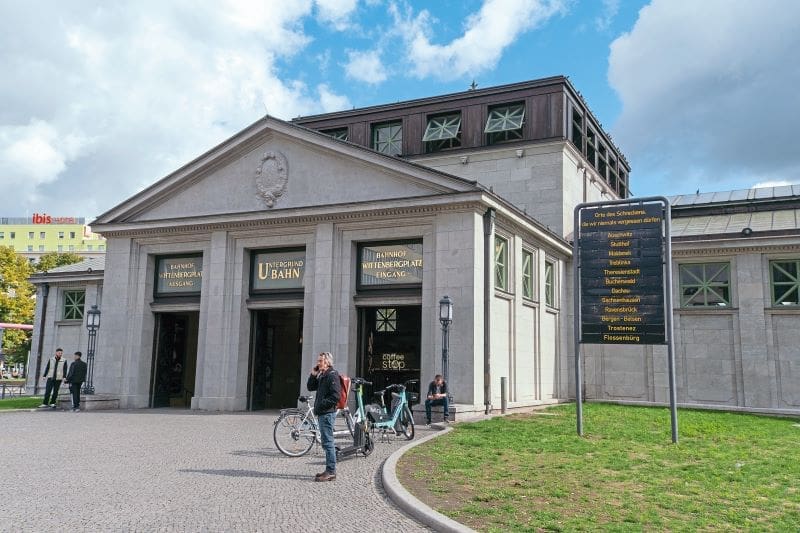
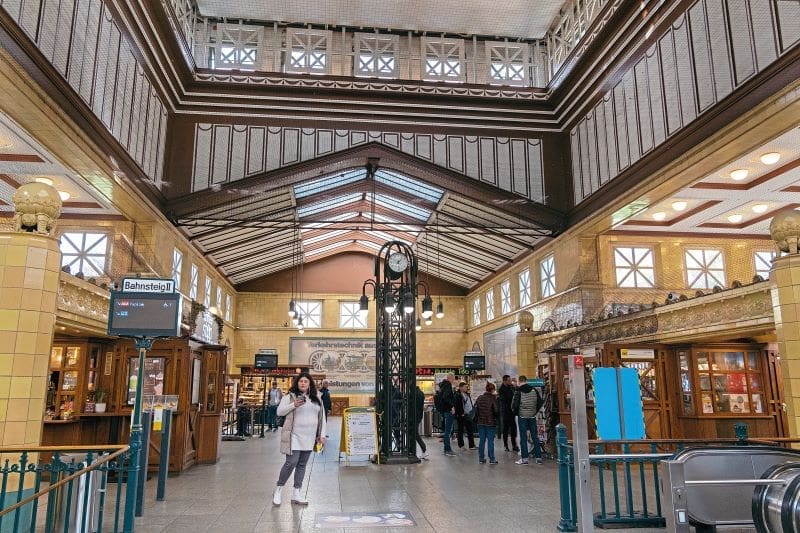
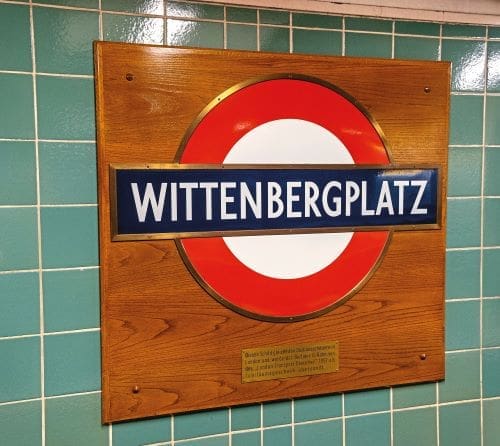 In the west of the city is Wittenbergplatz, which is one of the oldest U-Bahn stations, opening in 1902 and now a listed monument. Inside, the station retains many original Art Nouveau features, while outside the sign signifies the names of the concentration camps thousands of Jews were transported to. On one of the platforms is a London Underground roundel, far right, presented in 1952 by the London Transport Executive to mark the 50th anniversary of the U-Bahn.
In the west of the city is Wittenbergplatz, which is one of the oldest U-Bahn stations, opening in 1902 and now a listed monument. Inside, the station retains many original Art Nouveau features, while outside the sign signifies the names of the concentration camps thousands of Jews were transported to. On one of the platforms is a London Underground roundel, far right, presented in 1952 by the London Transport Executive to mark the 50th anniversary of the U-Bahn.
At large interchange stations such as Friedrichstrasse, which had checkpoints for passengers’ documents to be checked, the network of pedestrian tunnels was laid out in such a way to ensure passengers from the Democratic and Federal Republics remained segregated. Today, Nordbahnhof station hosts a permanent exhibition reflecting that era of the ghost stations.
By the summer of 1990, with the wall down and Germany beginning the long process of reunification, the ghost stations reopened, the first being Jannowitzbrücke on November 11, 1989. However, with changes to station walkways and the passage of time, it is almost impossible today to determine where passenger segregation took place.
Article continues below…Advert[4]The opening of the first line on the U-Bahn (the Berliner Hoch und Untergrundbahn – Berlin Elevated and Underground Railway) was built by Siemens & Halske and opened in 1902. The inaugural route was an elevated line on an east-west axis from Warschauer Strasse towards Nollendorfplatz. It remains one of the most interesting sections of a U-Bahn journey.

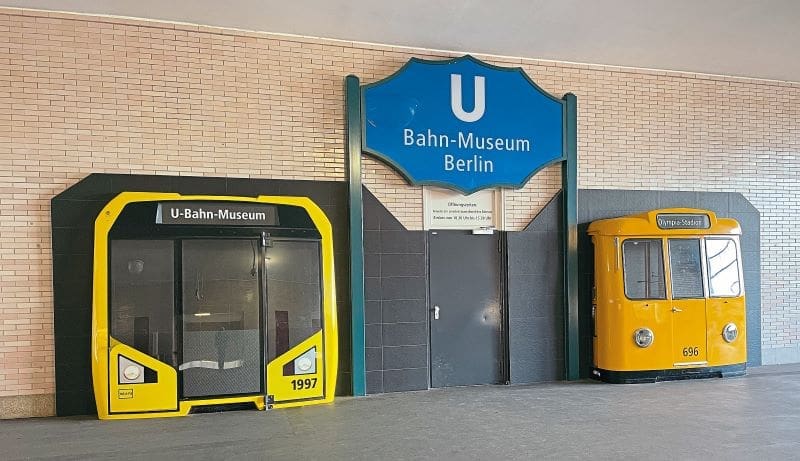 Olympia-Stadion, the penultimate station on line U2 (and not to be confused with Olympiastadion on line S3/S9, a short walk away), is located in the Westend and opened on June 8, 1913, ahead of the 1916 Olympics – which were cancelled due to war. After Berlin was awarded the 1936 Olympic games, the station was redesigned to what is seen today, by Alfred Grenander. It is also home to the U-Bahn museum and visible from the platforms is a maintenance depot for line U2.
Olympia-Stadion, the penultimate station on line U2 (and not to be confused with Olympiastadion on line S3/S9, a short walk away), is located in the Westend and opened on June 8, 1913, ahead of the 1916 Olympics – which were cancelled due to war. After Berlin was awarded the 1936 Olympic games, the station was redesigned to what is seen today, by Alfred Grenander. It is also home to the U-Bahn museum and visible from the platforms is a maintenance depot for line U2.
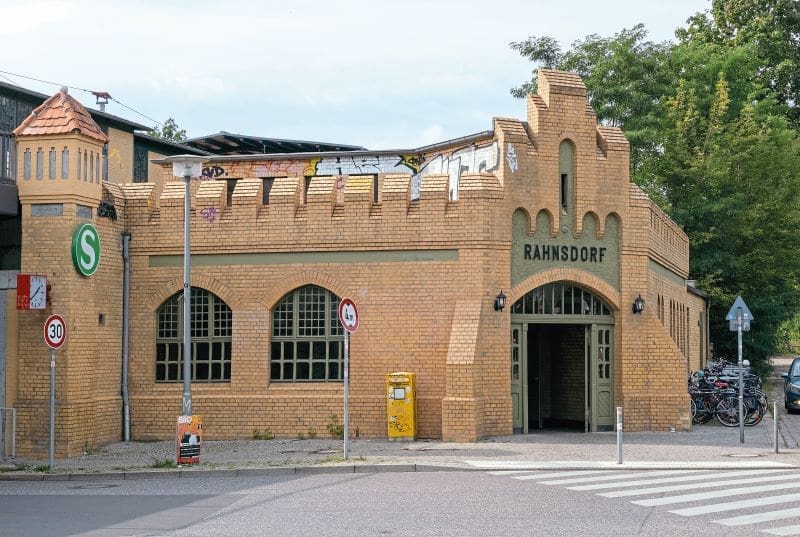
 Around 30 mins journey time from Alexanderplatz on line S3 is Rahnsdorf (above), where the street level building is of a modern castellated style. But the reason to visit this location is to ride the tramway to Woltersdorf using historic four-wheel trams built by Gotha/LEW between 1957-1961 (below). The 5.6km line has five passing loops and the fare is covered by an ABC ticket on Berlin’s VBB system. Unfortunately, to comply with access legislation, three new low-floor 15-metre long trams are due to arrive this autumn and the historic trams will see less use.
Around 30 mins journey time from Alexanderplatz on line S3 is Rahnsdorf (above), where the street level building is of a modern castellated style. But the reason to visit this location is to ride the tramway to Woltersdorf using historic four-wheel trams built by Gotha/LEW between 1957-1961 (below). The 5.6km line has five passing loops and the fare is covered by an ABC ticket on Berlin’s VBB system. Unfortunately, to comply with access legislation, three new low-floor 15-metre long trams are due to arrive this autumn and the historic trams will see less use.
Planning a visit
Several previous visits to Berlin for the biennial ‘Innotrans’ railway trade show had always been short in duration. Having first visited Berlin briefly in 1992, and again in 2005, a 2016 visit was accomplished as a day trip, home to Berlin and back in 22 hours – ridiculous in hindsight. Returning again in 2018, I stayed for a couple of nights, which was less frantic but still did not really allow sufficient time to see some of Berlin’s more fascinating railway stations featuring some very interesting railway architecture. With Innotrans cancelled in 2020 because of Covid-19, for 2022 I made plans for a four night/five day stay that also provided plenty of time to travel on a comprehensive network of lines and see more of the city.
Aware of some locations from past visits, I researched all other 175 U-Bahn and 168 S-Bahn stations using a couple of books – Capital Transport’s Berlin S-Bahn and Robert Schwandl’s excellent bi-lingual publication U-Bahn, S-Bahn & Tram in Berlin. I also found Wikipedia and other websites had pictures of most of the stations.
Article continues below…Advert[5] The attractive street level design of Krumme Lanke at the southern end of U3, designed by Swedish architect Alfred Grenander, is said to have been the inspiration for Charles Holden’s design of Chiswick Park station on the Piccadilly Line extension. Grenander was involved in the construction of some 70 U-Bahn stations, many of which have landmark status today.
The attractive street level design of Krumme Lanke at the southern end of U3, designed by Swedish architect Alfred Grenander, is said to have been the inspiration for Charles Holden’s design of Chiswick Park station on the Piccadilly Line extension. Grenander was involved in the construction of some 70 U-Bahn stations, many of which have landmark status today.
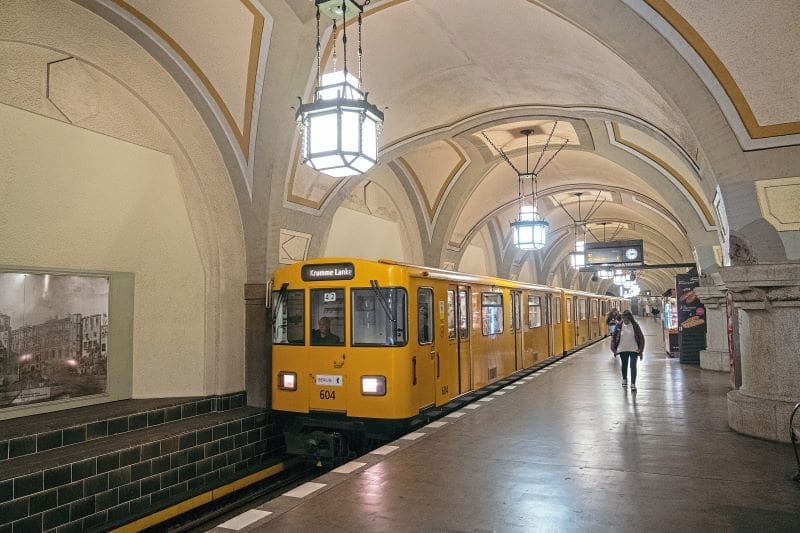 Opening in October 1913, one of the most ornate of Berlin’s U-Bahn stations is Heidelberger Platz on Line U3, where a train to Krumme Lanke is seen arriving. Heading towards Krumme Lanke, a number of the intermediate stations feature an interesting range of architectural styles.
Opening in October 1913, one of the most ornate of Berlin’s U-Bahn stations is Heidelberger Platz on Line U3, where a train to Krumme Lanke is seen arriving. Heading towards Krumme Lanke, a number of the intermediate stations feature an interesting range of architectural styles.
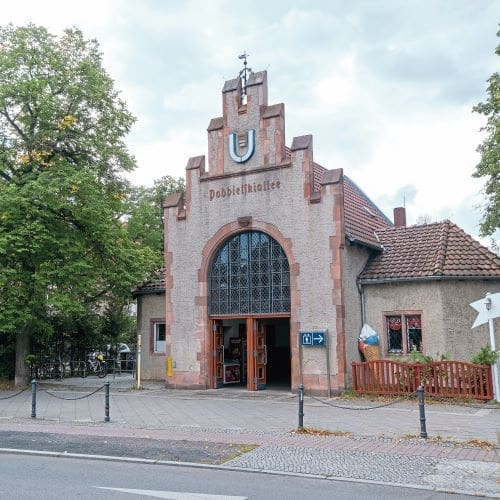 Podbielskiallee is two stops from Heidelberger Platz and one stop from Dahlem-Dorf, yet its church-style structure is in total contrast . This is where the line emerges from the tunnel heading towards Krumme Lanke.
Podbielskiallee is two stops from Heidelberger Platz and one stop from Dahlem-Dorf, yet its church-style structure is in total contrast . This is where the line emerges from the tunnel heading towards Krumme Lanke.
With a network length of 155km, U-Bahn stations are of varying style or design, many of those underground having different tiling – some coloured, some patterned. Some stations retain vintage lighting, but overall the stations have immense character. The stations of line S1 between Schöneberg and Wannsee are particularly diverse in their architecture.
Some 70 of the U-Bahn stations were designed by Swedish architect Alfred Grenander, his first designs being Art Nouveau or Neo-Classical before adopting a modern style. His notable designs include the cavernous Hermannplatz, Wittenbergplatz, Olympia-Stadion (built ahead of the cancelled 1916 Olympic Games) and Krumme Lanke, which is said to have inspired Charles Holden for his London Underground station designs.
The S-Bahn covers a wider area (a 339km network) and has evolved with fast and frequent cross-city services. Although many stations are modern, or have been rebuilt to cater for expanding population in certain areas, there are plenty that retain much of their original charm and character, having ornate canopies or buildings clad with ceramic tiles.
What is clear is how each station has a key place in the community it serves. Many have a cafe or bar attached where locals will socialise. Some had convenience stores integral to the design and a large number have flower shops.
 This unusual arch can be found at Buckower Chaussee, a station on line S2. The station was opened in May 1946, a requirement by the American occupation forces, but for many years was considered a temporary station on the then single-track S-Bahn line. The arch stems from the doubling of the line in the late 1980s, but has suffered some vandalism.
This unusual arch can be found at Buckower Chaussee, a station on line S2. The station was opened in May 1946, a requirement by the American occupation forces, but for many years was considered a temporary station on the then single-track S-Bahn line. The arch stems from the doubling of the line in the late 1980s, but has suffered some vandalism.
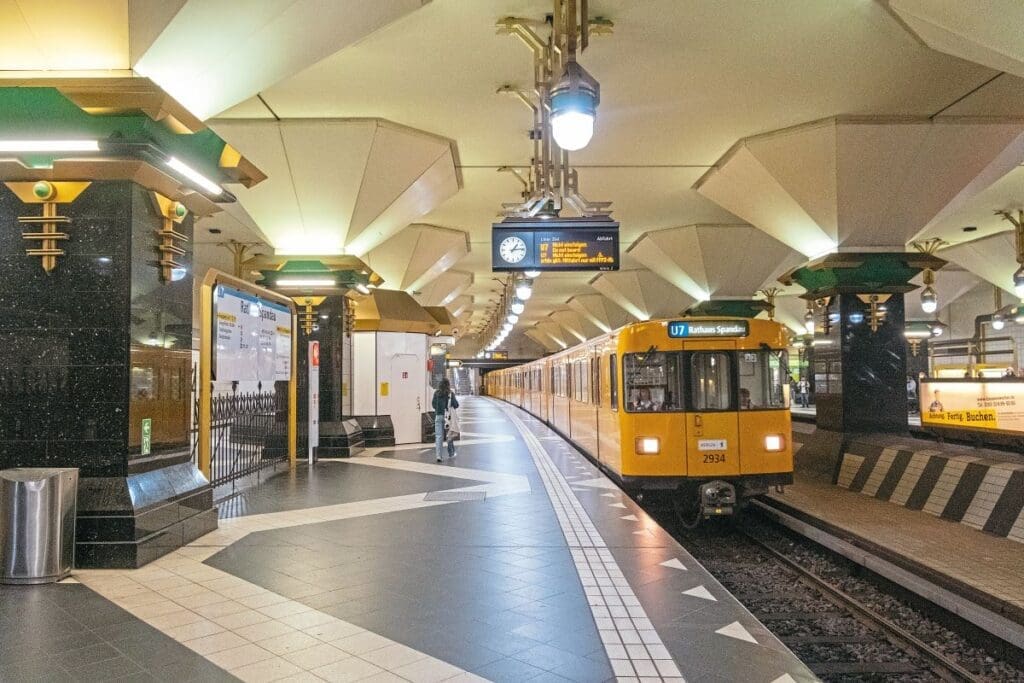 U-Bahn line U7 connects Spandau in the north-west with Rudow in the south east, and along its via 40 stations/19.8 mile route several stations have an interesting design. This is the rather elaborate northern terminus at Rathaus Spandau, finished in black granite with gold coloured lamps, and is the where ‘F’ series unit No. 2934 draws to a halt.
U-Bahn line U7 connects Spandau in the north-west with Rudow in the south east, and along its via 40 stations/19.8 mile route several stations have an interesting design. This is the rather elaborate northern terminus at Rathaus Spandau, finished in black granite with gold coloured lamps, and is the where ‘F’ series unit No. 2934 draws to a halt.
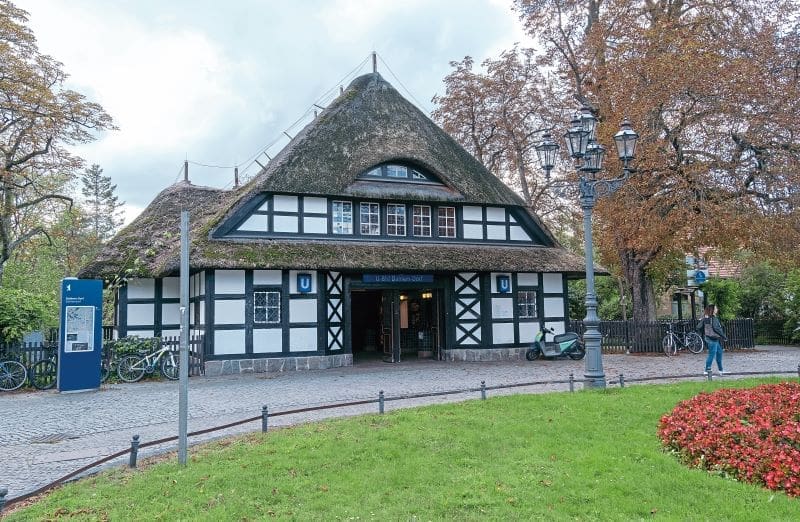 A station building with a thatched roof is probably not what you would expect to find in Berlin, but this is Dahlem-Dorf, also on U3, and is in the style of a traditional northern-German farmhouse. In April 2012, the station burned down (for a second time) but restored using synthetic fireproof roofing material.
A station building with a thatched roof is probably not what you would expect to find in Berlin, but this is Dahlem-Dorf, also on U3, and is in the style of a traditional northern-German farmhouse. In April 2012, the station burned down (for a second time) but restored using synthetic fireproof roofing material.
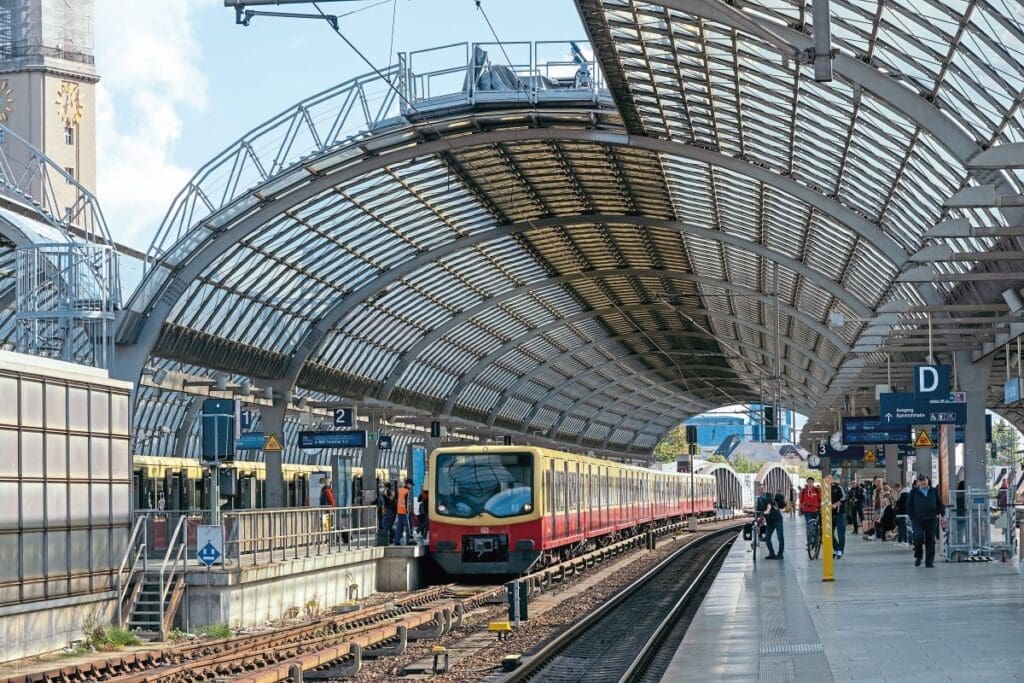 The busy station at Spandau, 14km from Berlin Hauptbahnhof, is directly served by many DB regional, Inter-City and EuroCity services and is at the end of S-Bahn lines S3 and S9. The first station at Spandau opened in 1871 on the Berlin–Lehrte railway, and a convoluted history followed. However, to meet railway expansion needs in the post reunification era, the current train shed style was created during a rebuild between 1996-1998.
The busy station at Spandau, 14km from Berlin Hauptbahnhof, is directly served by many DB regional, Inter-City and EuroCity services and is at the end of S-Bahn lines S3 and S9. The first station at Spandau opened in 1871 on the Berlin–Lehrte railway, and a convoluted history followed. However, to meet railway expansion needs in the post reunification era, the current train shed style was created during a rebuild between 1996-1998.
Maps and tickets
Having shortlisted which stations to visit, marked on the BVG network map, I used then Google maps to look at the location of each station, checking both the external and satellite views. Then, using the free app ‘maps.me’, I activated a public transport layer that showed the proximity of one station to another. This revealed some stations were far closer in reality than the schematic map – a 10-minute walk in one instance, saving a lengthy doubling back. I also used the BVG tram and bus maps to find other useful cross-city connections.
With the plan refined, I used the BVG app (or website) to establish station-to-station journey times, primarily to check if my plan was achievable or over ambitious. While there was some modification for one day, that was only a result of having aching feet due to a poor sock/shoe combination! So do wear comfortable footwear, as at the end of my trip I had walked a few steps short of 70,000 – equivalent to 29.6 miles!
 Further along U7 is Richard-Wagner-Platz, which opened in 1978 in conjunction with the extension of the line from Fehrbelliner Platz. The walls are tiled with Byzantine-style mosaics of medieval historic figures. Arriving is ‘H’ series unit 5010 on its way to Rudow.
Further along U7 is Richard-Wagner-Platz, which opened in 1978 in conjunction with the extension of the line from Fehrbelliner Platz. The walls are tiled with Byzantine-style mosaics of medieval historic figures. Arriving is ‘H’ series unit 5010 on its way to Rudow.
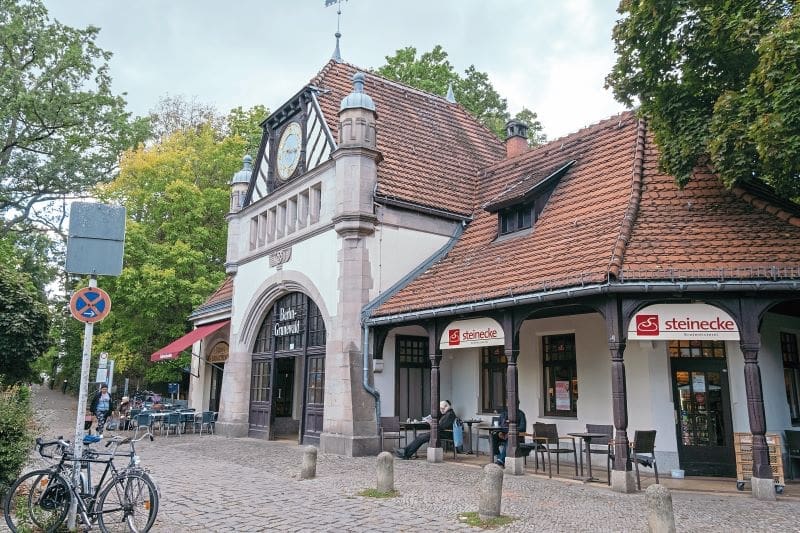 Grunewald station is west of the city and close to Forest Grunewald, its entrance hall being modelled on a castle gate and dates from 1899. The station has the unfortunate distinction as being a principal location for the deportation of 50,000 Jews to concentration camps during The Holocaust. A memorial, known as ‘Gleis 17’, is located on a ramp leading to the former freight yard.
Grunewald station is west of the city and close to Forest Grunewald, its entrance hall being modelled on a castle gate and dates from 1899. The station has the unfortunate distinction as being a principal location for the deportation of 50,000 Jews to concentration camps during The Holocaust. A memorial, known as ‘Gleis 17’, is located on a ramp leading to the former freight yard.
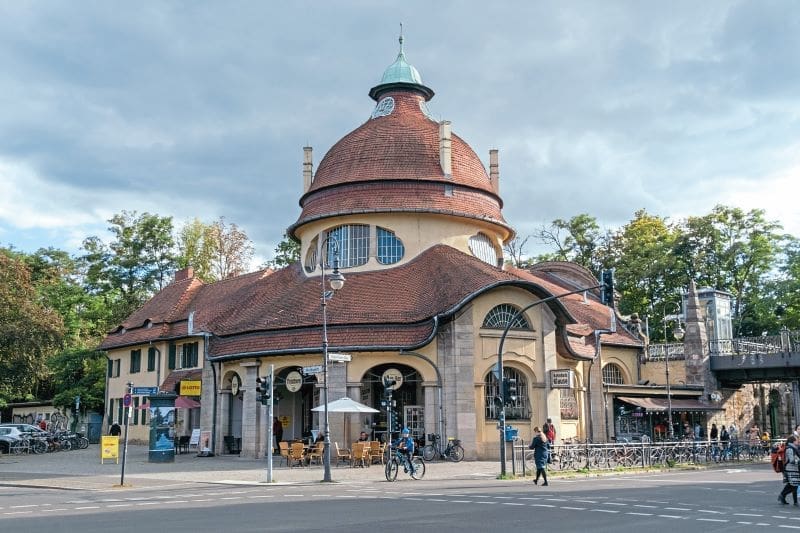 Berlin’s south-western suburbs have a wealth of beautiful stations, like Mexikoplatz on S-Bahn line S1 to Wansee. Dating from 1904, the station was first called Zehlendorf-Beerenstraße, then after two further name changes became Mexikoplatz in 1987. On the adjacent road overbridge are the letters KPEV (Königlich Preußische Eisenbahn-Verwaltung) for Prussian State Railways. Despite appearances on schematic maps, Krumme Lanke and Mexikoplatz are 1km apart.
Berlin’s south-western suburbs have a wealth of beautiful stations, like Mexikoplatz on S-Bahn line S1 to Wansee. Dating from 1904, the station was first called Zehlendorf-Beerenstraße, then after two further name changes became Mexikoplatz in 1987. On the adjacent road overbridge are the letters KPEV (Königlich Preußische Eisenbahn-Verwaltung) for Prussian State Railways. Despite appearances on schematic maps, Krumme Lanke and Mexikoplatz are 1km apart.
 South-west of Mexikoplatz is Nikolassee, which is served by trains on line S1 and S7 with island platforms on different alignments. The station building has a magnificent Neo-Gothic style and, like many commuter stations around the German capital, includes a snack bar, a convenience store and a florist’s shop.
South-west of Mexikoplatz is Nikolassee, which is served by trains on line S1 and S7 with island platforms on different alignments. The station building has a magnificent Neo-Gothic style and, like many commuter stations around the German capital, includes a snack bar, a convenience store and a florist’s shop.
As regards travel tickets, a trade pass for Innotrans provides free travel in Berlin zones ABC, but tourists can use a 24-hour travelcard/pass for €10.70, a bargain considering the standard single journey ticket is €2.20 or 3.20, depending on distance.
With no ticket gates to battle with, you can just wander on to platforms, which is perfect for a rail enthusiast. But be warned, there are on-train ticket checks by plain-clothed BVG officials, and if caught with no ticket, a hefty €60 fine is levied.
In respect of traction, Berlin’s U-Bahn still uses many of the characteristic F-type trains dating from the 1970s, supplemented by newer G, H, HK and IK units. The S-Bahn uses a mix of Class 481/482 stock dating from 1995, new Class 483/484 and a small number of Class 480/485 built in the 1980s.
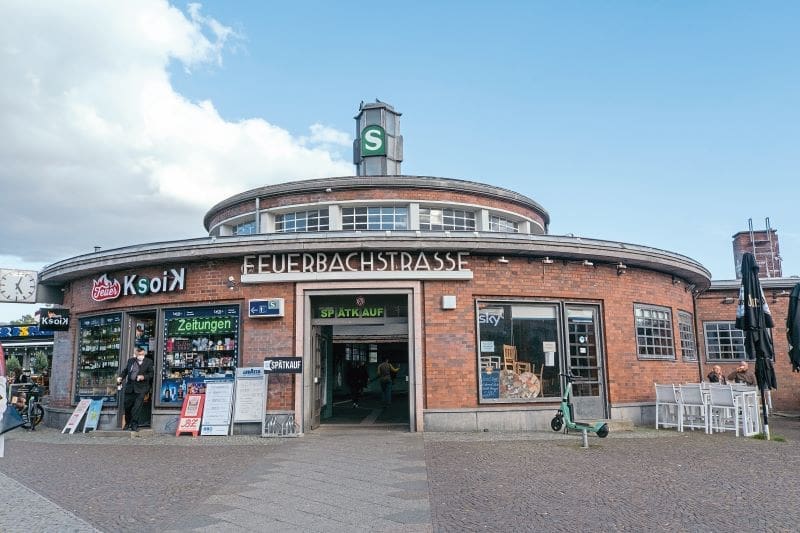 Feuerbachstraße, in its Art Deco/Streamline Moderne style, was opened on May 15, 1933 as part of the electrification of the line to Wansee. It has remarkable similarities to Charles Holden’s Southgate station on the northern section of London’s Piccadilly line, which opened on March 13, 1933 – just two months earlier.
Feuerbachstraße, in its Art Deco/Streamline Moderne style, was opened on May 15, 1933 as part of the electrification of the line to Wansee. It has remarkable similarities to Charles Holden’s Southgate station on the northern section of London’s Piccadilly line, which opened on March 13, 1933 – just two months earlier.
 Midway along Berlin’s Stadtbahn elevated railway is Hackescher Markt, a station formerly in East Germany before reunification. Opened in 1882 and originally named Börse, then renamed in 1992, it remains one of the city’s busiest stations handling services on S-Bahn lines S3, S5, S7 and S9, while DB services pass the station on adjacent lines. The station’s ornate brickwork (inside and out) is well worth seeing and is one of only two Stadtbahn stations in original condition, the other being Bellevue.
Midway along Berlin’s Stadtbahn elevated railway is Hackescher Markt, a station formerly in East Germany before reunification. Opened in 1882 and originally named Börse, then renamed in 1992, it remains one of the city’s busiest stations handling services on S-Bahn lines S3, S5, S7 and S9, while DB services pass the station on adjacent lines. The station’s ornate brickwork (inside and out) is well worth seeing and is one of only two Stadtbahn stations in original condition, the other being Bellevue.
 The completion of an extension of U-Bahn line U5 to connect with the short U55 line (Hauptbahnhof to Brandenburger Tor) took 10 years to achieve and was completed in December 2020 with three new stations. This is one of them at Rotes-Rathaus, where a train from Hönow to Hauptbahnhof arrives.
The completion of an extension of U-Bahn line U5 to connect with the short U55 line (Hauptbahnhof to Brandenburger Tor) took 10 years to achieve and was completed in December 2020 with three new stations. This is one of them at Rotes-Rathaus, where a train from Hönow to Hauptbahnhof arrives.
Much to see and do
As a vibrant cosmopolitan city, there were no concerns over personal safety, but you should always be alert. Neither were there any issues whatsoever taking pictures at stations, including underground – although use a high ISO where necessary and not a flash. There are plenty of places to eat and drink too as you move around the city.
The city’s railways play an important part of Berlin’s rich history and connect to the famous tourist sites, such as the Reichstag, Brandenburg Gate, Deutsches Technikmuseum, the Fernsehturm (TV tower), Checkpoint Charlie, the Jewish Museum and Rotes Rathaus. The extensive S-Bahn and regional DB services also connect the city centre with Berlin Brandenburg airport and further afield.
 Warschauer Straße U-Bahn station, at the eastern end of the Oberbaumbrücke, another busy station that also retains an overall roof and elevated signalbox. Adjacent is a U-Bahn depot. Lines U1 and U3 start here and the elevated line, which goes east-west and is underground after Gleisdreieck, is worthy of exploration in its own right.
Warschauer Straße U-Bahn station, at the eastern end of the Oberbaumbrücke, another busy station that also retains an overall roof and elevated signalbox. Adjacent is a U-Bahn depot. Lines U1 and U3 start here and the elevated line, which goes east-west and is underground after Gleisdreieck, is worthy of exploration in its own right.
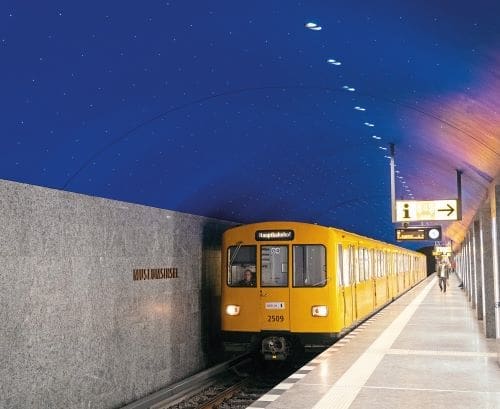 The second of three new stations on the new section of U5 is Museumsinsel, where a dark blue ceiling contains hundreds of points of light to represent a starry sky. The inspiration for the design was the opera The Magic Flute.
The second of three new stations on the new section of U5 is Museumsinsel, where a dark blue ceiling contains hundreds of points of light to represent a starry sky. The inspiration for the design was the opera The Magic Flute.
There are some gems too. South-east of Berlin on S-Bahn line S3 is Rahnsdorf (40mins from Alexanderplatz), where across the road from the station is tram line 87 that runs through an attractive suburb to Woltersdorf. The line, which is 110 years old, still uses 60-year-old twin-axle Gotha trams – but not for much longer, as new modern trams are on order. The ride is included with the all-zones pass too.
The city does have a U-Bahn Museum near the Olympia-Stadion station, which is temporarily closed as a result of the pandemic, while a new S-Bahn museum at Lichtenberg station is under construction and scheduled to open in August 2024.
Berlin is a tremendous city to visit for a short break, easy to get around, with accommodation choices to suit all pockets and so much of interest for all tastes. Something to consider for the late summer or autumn?
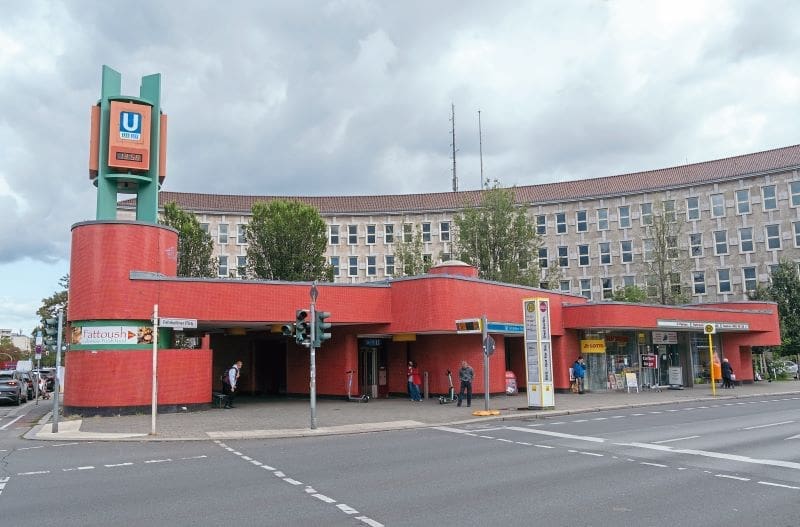 The U-Bahn station at Fehrbelliner (lines U3 and U7) has been rebuilt several times over the years, the current style is said to resemble a 1970s oil rig. Behind the station is one of a number administrative buildings that surround the station completed during the Nazi era of the 1930s and 40s.
The U-Bahn station at Fehrbelliner (lines U3 and U7) has been rebuilt several times over the years, the current style is said to resemble a 1970s oil rig. Behind the station is one of a number administrative buildings that surround the station completed during the Nazi era of the 1930s and 40s.
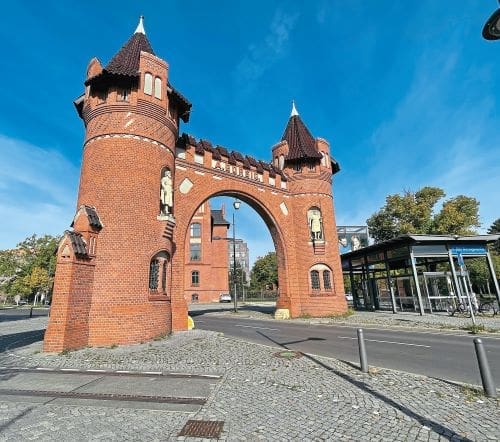 This magnificent brick archway is the gateway to the former Borsig locomotive works in Berlin’s north-west Tegel district and dates from 1898. Completed locomotives would exit through the archway, which is next to Borsigwerke U-Bahn station on line U6. Today, much of the Borsig site has been redeveloped, but some of the original workshop buildings survive and are used for a mix of office and domestic accommodation, as well as a shopping mall.
Advert[6]
This magnificent brick archway is the gateway to the former Borsig locomotive works in Berlin’s north-west Tegel district and dates from 1898. Completed locomotives would exit through the archway, which is next to Borsigwerke U-Bahn station on line U6. Today, much of the Borsig site has been redeveloped, but some of the original workshop buildings survive and are used for a mix of office and domestic accommodation, as well as a shopping mall.
Advert[6]